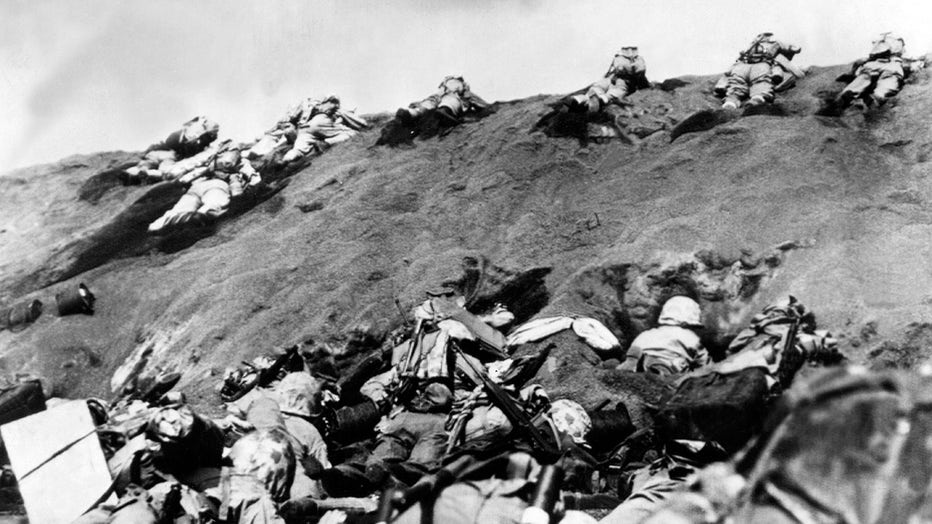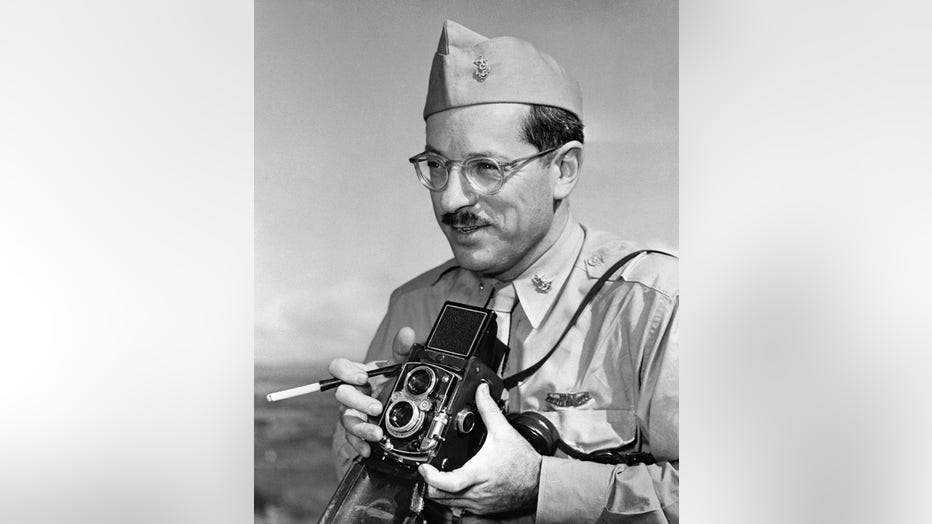Iwo Jima flag raising: The story behind the iconic photo
View of members of the United States Marine Corps 5th Division as they raise an American flag on Mount Suribachi during the Battle of Iwo Jima, February 23, 1945. (Photo by Joe Rosenthal/Photo 12/Universal Images Group via Getty Images)
February 23 marks the day the United States Marines raised America’s flag over Mount Suribachi in Japan during the Battle of Iwo Jima almost 80 years ago.
The moment has been immortalized in a famous photograph taken by Associated Press photographer Joe Rosenthal.
Take a look back at the history of the iconic photo, the lesser known first flag and the battle of Iwo Jima.
Battle of Iwo Jima

American soldiers fighting against the Japanese in Iwo Jima on March 1945. (Photo by Keystone-France/Gamma-Keystone via Getty Images)
The Battle of Iwo Jima began after American forces invaded the island on Feb. 19, 1945.
The battle lasted for five weeks and was considered one of the bloodiest military campaigns of World War II and in the history of the Marine Corps, according to The National WWII Museum.
It was estimated that almost 7,000 Marines lost their lives and all but roughly 200 of the 21,000 Japanese forces were killed, according to History.com.
Following the capture of Iwo Jima, the longest and largest battle in the Pacific took place during the invasion of Okinawa, Japan.
Twenty-seven Medals of Honor were awarded to service members for their actions at Iwo Jima – the most in the history of the U.S., according to The National WWII Museum.
Flag raising on Iwo Jima
On Feb. 23, 1945, U.S. forces took Mount Suribachi and were photographed raising the American flag at the summit.
The iconic photo won Rosenthal, the photographer, a Pulitzer Prize.

Joe Rosenthal, a veteran AP cameraman, who took the famous picture of the flag raising at Iwo Jima, holding camera. (Bettmann via Getty Images)
That photo shows the second flag that was erected on the mountain. A photo of the first flag that was raised shows a completely different angle and a completely different flag.
As several Marines raised the first flag on Mount Suribachi, Marine Staff Sgt. Louis Lowrey from Leatherneck Magazine captured a photo. However, after that first flag was raised, Japanese forces began to shoot and Lowrey ended up dropping his camera while ducking for cover, according to Military.com.
As Lowrey descended the mountain to get new gear, AP photographer Rosenthal was ascending the mountain.
In response to seeing Japanese forces’ reaction to the flag being erected on the mountain, Marine Corps Lt. Col. Chandler Johnson ordered for a new and larger American flag to be raised, according to the Marines website.
This new flag raising was the moment Rosenthal captured and became one of the most famous photos in American history.
Who raised the Iwo Jima flags?

Installing large flag on Mt. Suribachi. (Photo by: Universal History Archive/Universal Images Group via Getty Images)
The service members who raised the first flag on Mount Suribachi were: 1st Lt. Harold G. Schrier, Plt. Sgt. Ernest I. Thomas, Jr., Sgt. Henry O. Hansen, Cpl. Charles W. Lindberg, Pharmacist Mate 2nd Class John H. Bradley and Pvt. Philip L. Ward, according to the Marine Corps website.
Following Iwo Jima, Schrier fought in the Korean War and was promoted to Major in 1951. He would retire from the Marines as a lieutenant colonel, according to the Military Hall of Honor website. He died in 1971 in Florida.
Lindberg said that many did not believe him when he said he helped raise one of the two flags in Iwo Jima, according to a New York Times report.
Lindberg spent his final years raising awareness about the first flag-raising and spoke at veterans groups and schools, The Times said.
He died in June of 2007.
Bradley, who was originally misidentified in the photo of the second (more famous) flag raising, passed away in 1994 and his son, James Bradley, later wrote a book titled "Flags of Our Fathers" in 2000. The book’s storyline centered around the flag-raising in Iwo Jima and the famous photograph that came from it. A movie adaptation of the book directed by Clint Eastwood was released in 2006, according to IMDB.
Controversy surrounded the book after it was found that some of the Marines, including Bradley, in the second flag-raising photograph were misidentified.
The Marine Corps formally recognized the misidentification and in 2016, a corrected list of names for both the first flag-raising and second were released.
Ward was one of the Marines not identified as one of the original men who helped raise the first flag on Mount Suribachi and was part of the amended list of Marines released in 2016.
Ward was posthumously recognized for his part in the battle as he died on Dec. 28, 2005, according to We Are the Mighty.
Thomas and Hansen died in battle.
Those who were responsible for the second flag-raising were: Pfc. Harold Keller, Pfc. Harold Schultz, Cpl. Harlon Block, Pfc. Franklin Sousley, Sgt. Michael Strank and Pfc. Ira Hayes.
In 2019, the Marine Corps, in collaboration with the Federal Bureau of Investigation and historian Brent Westmeyer, revealed that Keller was misidentified as Cop. Rene Gagon in the famous photograph of the second flag-raising.
Keller survived the war and went back home to Iowa where he lived with his wife Ruby and three children until he died of a heart attack in 1979, according to the Des Moines Register.
Hayes, who was a member of the Pima Indian Tribe, was dubbed a war hero by President Dwight D. Eisenhower when he returned to the U.S.
Hayes struggled with PTSD and survivor’s guilt, according to the Museum of Native American History. He died at the age of 32 near his home in Sacaton, Arizona.
Schultz returned to the U.S. and worked for the Postal Service until his retirement in 1981, according to We Are The Mighty.
He seldomly spoke of his time in the war and only revealed any details to his stepdaughter, Dezreen Macdowell. She would go on to be interviewed by Time Magazine and lauded her stepfather as a war hero.
Schultz died on May 16, 1955.
Block, Strank and Sousley were killed in action in Iwo Jima.
This story was reported from Los Angeles.

